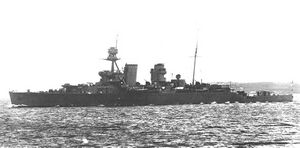HMNS Hollens
 Hollens, 1953
| |
| History | |
|---|---|
| Name: | Hollens |
| Namesake: | Admiral the Viscount Hollens |
| Ordered: | March 1948 |
| Builder: | J.M Loughton and Sons, Brumley |
| Laid down: | February 1950 |
| Launched: | June 1951 |
| Commissioned: | 12th December 1951 |
| Fate: | Sold for scrap, 1971 |
| General characteristics | |
| Class and type: | Admiral-class gun-cruiser |
| Displacement: | 10,800 long tons (11,000 t) (standard) |
| Length: | 605 ft 1.5 in (184.4 m) |
| Beam: | 65 ft (19.8 m) |
| Draught: | 19 ft 3 in (5.9 m) (deep load) |
| Installed power: | Eight Admiralty Standard boilers |
| Propulsion: | Four shaft steam turbines |
| Speed: | 30 knots (56 km/h; 35 mph) |
| Range: | 8,000 nmi (15,000 km; 9,200 mi) at 16 knots (30 km/h; 18 mph) |
| Complement: | 564 (612 as flagship) |
| Armament: |
|
| Armour: |
|
HMNS Hollens was an Admiral-class cruiser built for the Vionna-Frankenlischian Imperial Navy in the early 1950s. Hollens saw service throughout the 1950s and 60s, with its Imperial Navy career ending in 1967 when it was captured during the Imperial Civil War. She was decomissioned in 1970 and scrapped the following year as surplus to requirements by the Red Banner Navy of the DPRVF.
Design and description
The Admiral-class cruisers were designed during the ministry of Clarence Addlington as the first of the modern Vionna-Frankenlischian gun-cruisers. At the time, government budgeting meant that the Imperial Navy needed solid multi-purpose ships which could be built cheaply. In the case of the Admiral-class, priority was placed on designing a ship which could keep up with most surface combatants, provide close-range anti-air cover, and carry a significant enough gun armament to carry out shore bombardment and engage other cruisers and destroyers. Long range was also a desired feature for hunting down enemy commerce raiders.
Hollens had an overall length of 605 feet 1.5 inches (184.4 m), a beam of 65 feet (19.8 m), and a draught of 19 feet 3 inches (5.9 m). She displaced 10,800 long tons (11,000 t). Her crew consisted of 564 officers and ratings, this increased to 612 when deployed as a flagship - with the additional numbers coming from the admiral's staff and a strengthened complement of marines. Hollens was powered by eight Admiralty Standard boilers driving four steam turbines with a propellor shaft each. The power provided by these gave her a maximum speed of 30 knots (56 km/h; 35 mph), and she had a range of 8,000 nmi (15,000 km; 9,200 mi) at 16 knots (30 km/h; 18 mph).
The main armament of the Admiral-class ships consisted of seven 7.5-inch (191 mm) guns in single mounts protected by 1-inch (25 mm) gun shields. They were arranged with five guns on the centreline, four of which were in superfiring pairs fore and aft of the superstructure, the fifth gun on the quarterdeck, and the last two as wing guns abreast the aft funnel. Twelve single 3 in (76 mm) dual-purpose guns were mounted about the ship, with seven deployed beside the main guns (one per gun), four positioned around the central superstructure (two to each side), and the twelth gun mounted on a platform behind the funnel. These guns were radar-guided for their anti-aircraft role. The rest of the Admiral-class' anti-aircraft gun suite consisted of four quad radar-guided 20mm guns and four dual 40mm Bofors guns. These were later complemented aboard Hollens and Caledon by eight dual Seacat missile launchers, the first deployment of these new weapons aboard cruisers. The launchers were installed in 1960 and cost more than the rest of Hollens's AA suite put together. The ships' armament was completed by four individual deck-mounted torpedo tubes (two per side).
The Admiral-class were protected by a full-length waterline armoured belt that covered most of the ships' sides. It was thickest over the boiler and engine rooms, ranging from 1.5 to 3 inches (38 to 76 mm) thick. Their magazines were protected by an additional 0.5 to 1 inch (13 to 25 mm) of armour. There was a 1-inch aft transverse bulkhead and the conning tower was protected by 3-inch armour plates. The ships' deck protection consisted of 1 to 1.5 inches of high-tensile steel.
Construction and career
Hollens was named after Admiral the Viscount Hollens. The ship was ordered in March 1948 and laid down in February 1950, she was launched in June 1951 and comissioned into service as HMNS Hollens on 12th December 1951. She was constructed by J.M Loughton and Sons in Brumley, a private shipbuilders which were often trusted with naval contracts and were renowned as reliable builders of cruisers and large destroyers. J.M Loughton and Sons had already constructed Hollens' sister, Caledon, the first ship of the Admiral-class.